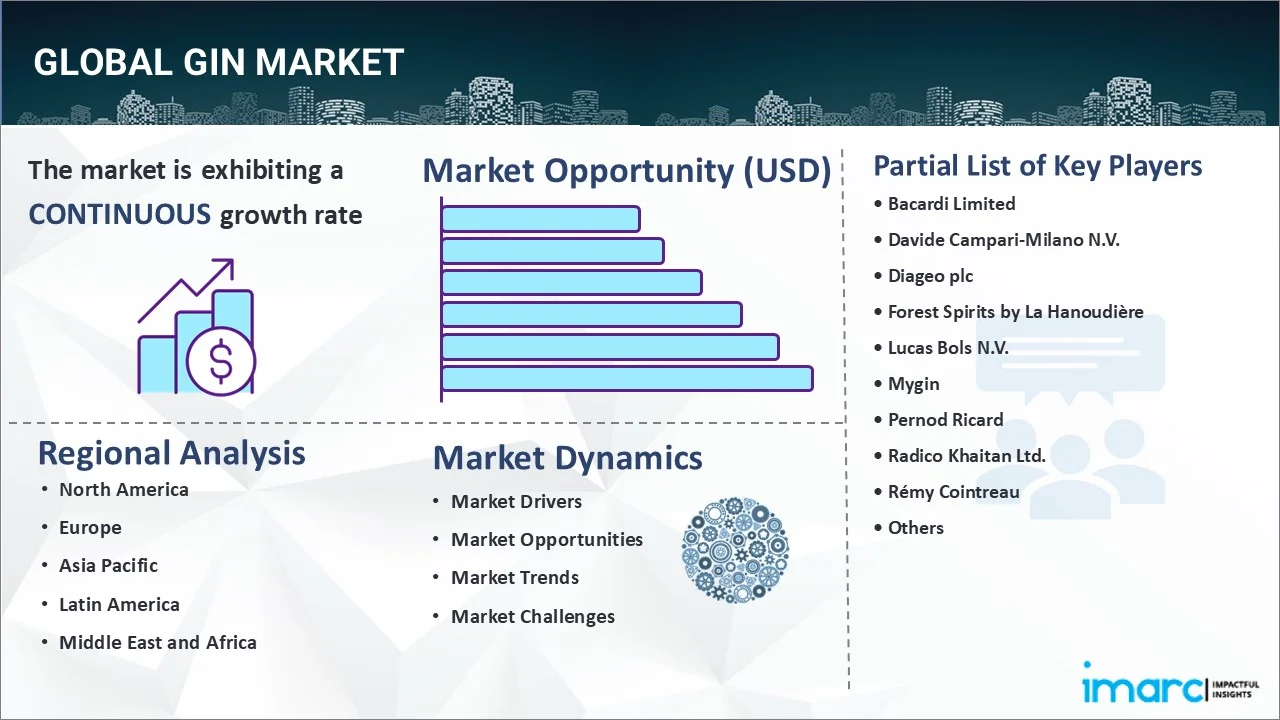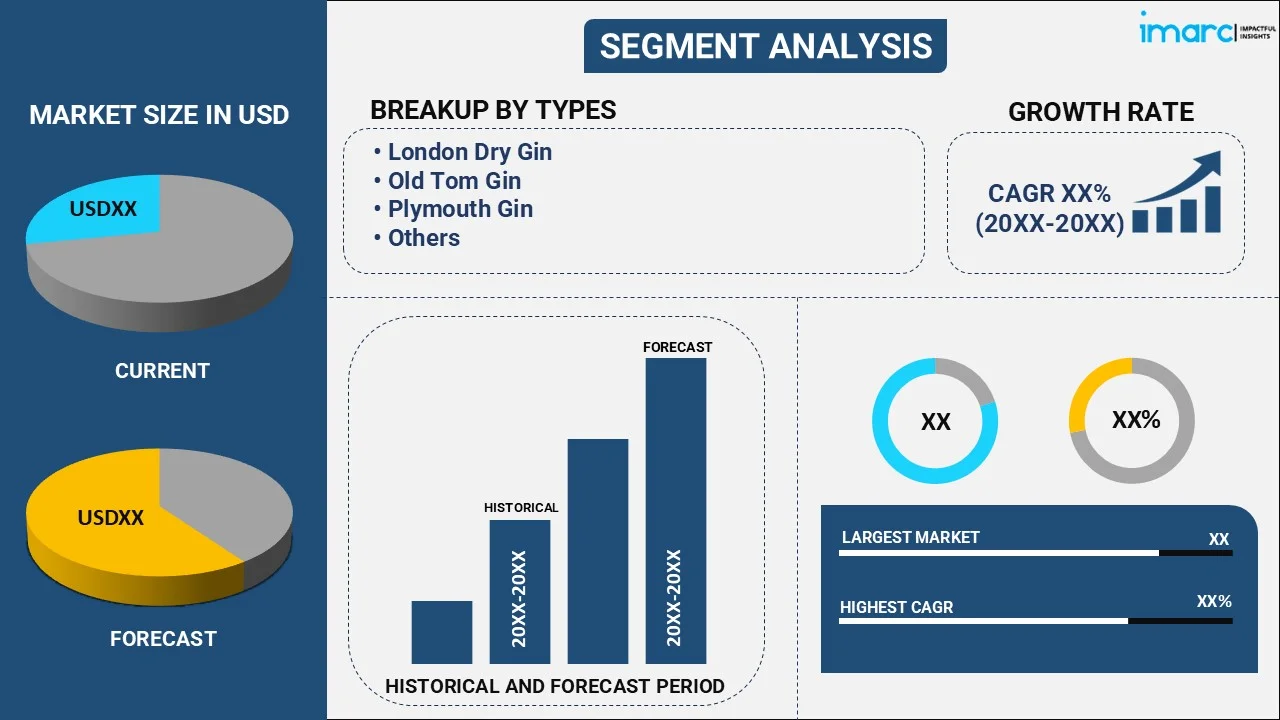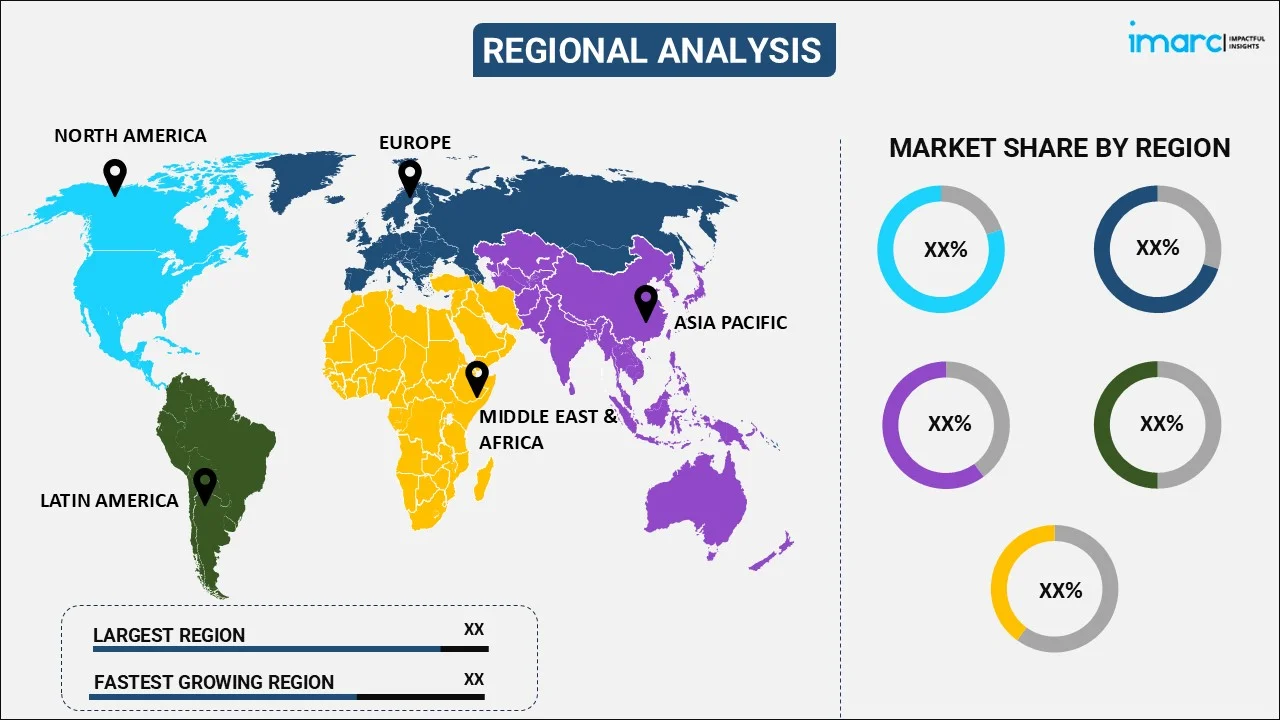
Gin Market Report by Type (London Dry Gin, Old Tom Gin, Plymouth Gin, and Others), Price Point (Standard, Premium, Luxury), Distribution Channel (On-trade, Off-trade), and Region 2025-2033
Gin Market Size:
The global gin market size reached USD 16.7 Billion in 2024. Looking forward, IMARC Group expects the market to reach USD 23.9 Billion by 2033, exhibiting a growth rate (CAGR) of 3.69% during 2025-2033. The market is propelled by the rising demand for premium and craft gin, increasing popularity of gin-based cocktails, growth in gin tourism, expansion of flavored and innovative gin varieties, growth in low-alcohol and non-alcoholic gin options, and emphasis on sustainable and eco-friendly production practices.
|
Report Attribute
|
Key Statistics
|
|---|---|
|
Base Year
|
2024
|
|
Forecast Years
|
2025-2033
|
|
Historical Years
|
2019-2024
|
|
Market Size in 2024
|
USD 16.7 Billion |
|
Market Forecast in 2033
|
USD 23.9 Billion |
| Market Growth Rate 2025-2033 | 3.69% |
Gin Market Analysis:
- Major Market Drivers: Major market drivers of the gin market include increasing demand for premium and craft gin, growing popularity of gin-based cocktails, and growth in gin tourism and experiential marketing.
- Key Market Trends: Expansion of flavored and innovative gin varieties, growth in low-alcohol and non-alcoholic gin options, and emphasis on sustainable eco-friendly production practices, representing some of the major key market trends.
- Geographical Trends: Increasing consumer preference for premium and artisanal gin, increasing popularity of gin cocktails and growth of gin distilleries and craft brands is further driving the Europe gin market demand.
- Competitive Landscape: Some of the major market players in the gin industry include Bacardi Limited, Davide Campari-Milano N.V., Diageo plc, Forest Spirits by La Hanoudière, Lucas Bols N.V., Mygin, Pernod Ricard, Radico Khaitan Ltd., Rémy Cointreau, San Miguel Corporation, The East India Company Ltd., William Grant & Sons Ltd, among many others.
- Challenges and Opportunities: Some of the major challenges include regulatory restrictions, robust competition, and varying raw material costs. Whereas, expansion into untapped markets, significant developments in flavors and product offerings, and growth of offline and direct-to-consumer sales channels are some of the gin market recent opportunities.

Gin Market Trends:
Rising Demand for Premium and Craft Gin
The global gin market is experiencing a significant shift toward premium and craft gin, driven by increasing consumer interest in high-quality, artisanal beverages. This trend reflects a broader movement in the alcohol industry where consumers are prioritizing quality over quantity and seeking unique, authentic experiences. Premium and craft gins are characterized by their use of high-quality ingredients, distinctive botanicals, and innovative production techniques, which appeal to discerning consumers who are willing to pay a premium for a superior product. As per GITNUX, the premium gin segments held almost 40% of the global revenue in 2020. This growth is fueled by consumers' desire for more complex and nuanced flavors, as well as their increasing interest in the stories and craftsmanship behind the brands. Craft gins, in particular, are benefitting from the trend toward local and artisanal products, with many consumers favoring smaller, independent distilleries that offer unique and small-batch creations, thereby leading to a significant gin market growth.
Expansion of Flavored and Innovative Gin Varieties
The expansion of flavored and innovative gin varieties is a major factor creating a positive gin market overview. Consumers are increasingly seeking new and exciting flavors, leading gin producers to explore a wide range of botanical and fruit infusions. This trend has led to a proliferation of unique gin varieties, each offering distinct flavor profiles and sensory experiences. Flavored gins, such as those infused with berries, spices, herbs, and even exotic fruits, cater to diverse palates and preferences, thereby attracting a broader audience. According to a report by GITNUX, the flavored and colored gins hold 40% of total gin sales growth in 2020. This substantial growth is indicative of the strong consumer interest in innovative gin products. The gin market recent developments of new flavors and combinations appeals to adventurous drinkers and also enhances the versatility of gin in cocktails. For instance, gin brands are experimenting with seasonal and limited-edition flavors, which can create buzz and drive short-term spikes in sales.
Growth of Online and Direct-to-Consumer Sales Channels
The growth of online and direct-to-consumer (DTC) sales channels is significantly contributing to a positive gin market revenue, by providing consumers with greater access to a wide range of gin products. The rise of e-commerce and digital platforms has transformed how consumers discover, purchase, and enjoy gin. Online sales channels enable gin brands to reach a global audience, bypassing traditional retail limitations and offering convenience and accessibility to consumers. According to GITNUX, online gin sales increased by 42% in 2020. This growth is driven by increasing consumer comfort with online shopping, the proliferation of digital marketing strategies, and advancements in e-commerce technology. Online platforms provide consumers with access to a wider selection of gin brands and varieties, including those that may not be available locally, thereby creating a positive gin market outlook.
Gin Market Segmentation:
IMARC Group provides an analysis of the key trends in each segment of the market, along with forecasts at the global, regional, and country levels for 2025-2033. Our report has categorized the market based on type, price point, and distribution channel.
Breakup by Type:

- London Dry Gin
- Old Tom Gin
- Plymouth Gin
- Others
London dry gin accounts for the majority of the market share
The report has provided a detailed breakup and analysis of the market based on the type. This includes London dry gin, old tom gin, Plymouth gin, and others. According to the report, London dry gin represented the largest segment.
London dry gin holds the largest gin market share due to its established reputation for quality and consistency. It adheres to strict production standards, ensuring a distinct and reliable flavor profile that appeals to both consumers and bartenders. The emphasis on traditional botanicals, primarily juniper, along with a consistent distillation process, creates a classic taste that defines the category. Its versatility in cocktails and widespread recognition contribute to its popularity. Additionally, the historical significance and marketing efforts by major brands bolster its leading position in the market, making London Dry Gin a preferred choice among gin enthusiasts globally.
Breakup by Price Point:
- Standard
- Premium
- Luxury
Premium holds the largest share of the industry
A detailed breakup and analysis of the market based on the price point have also been provided in the gin market report. This includes standard, premium, and luxury. According to the report, premium accounted for the largest market share.
Premium gin is the largest segment in the global gin market due to consumers' increasing preference for high-quality spirits with unique flavors and superior ingredients. The growing trend of craft cocktails and mixology has led to a demand for premium gin, which is often associated with superior craftsmanship and artisanal production methods. Additionally, premium gin brands invest heavily in marketing and branding, positioning their products as luxury items and status symbols. This has resonated well with a demographic willing to pay more for an enhanced drinking experience, contributing significantly to the dominance of the segment in the market.
Breakup by Distribution Channel:
- On-trade
- Off-trade
On-trade represents the leading market segment
The report has provided a detailed breakup and analysis of the market based on the distribution channel. This includes on-trade and off-trade. According to the report, on-trade represented the largest segment.
On-trade channels dominate the global gin market due to the experiential appeal and social aspect of consuming gin in bars, restaurants, and clubs. These venues offer unique, curated gin experiences, often featuring exclusive cocktails crafted by skilled mixologists. The ambiance, service, and social interactions enhance the overall drinking experience, making on-trade venues a preferred choice for consumers seeking premium and innovative gin offerings. According to the gin market forecast, the rising trend of gin-based events and promotions in these establishments contributes to the significant share of the on-trade segment, as it fosters brand loyalty and drives higher consumption rates.
Breakup by Region:

- North America
- United States
- Canada
- Asia-Pacific
- China
- Japan
- India
- South Korea
- Australia
- Indonesia
- Others
- Europe
- Germany
- France
- United Kingdom
- Italy
- Spain
- Russia
- Others
- Latin America
- Brazil
- Mexico
- Others
- Middle East and Africa
Europe leads the market, accounting for the largest gin market share
The report has also provided a comprehensive analysis of all the major regional markets, which include North America (the United States and Canada); Europe (Germany, France, the United Kingdom, Italy, Spain, Russia, and others); Asia Pacific (China, Japan, India, South Korea, Australia, Indonesia, and others); Latin America (Brazil, Mexico, and others); and the Middle East and Africa. According to the report, Europe was the largest regional market for gin.
Europe is the largest segment in the global gin market due to its rich history and deep cultural association with gin production and consumption. The region boasts several renowned gin-producing countries, such as the UK, Spain, and the Netherlands, each with a strong heritage and established distilleries. Additionally, the popularity of gin-based cocktails and the increasing trend of premiumization have fueled demand. The presence of major gin brands and continuous product innovations cater to diverse consumer preferences. Furthermore, the robust distribution channels of Europe and extensive marketing strategies ensure widespread availability and visibility, solidifying its dominance in the global gin market.
Competitive Landscape:
The market research report has also provided a comprehensive analysis of the competitive landscape in the market. Detailed profiles of all major companies have also been provided. Some of the major market players in the gin industry include:
- Bacardi Limited
- Davide Campari-Milano N.V.
- Diageo plc
- Forest Spirits by La Hanoudière
- Lucas Bols N.V.
- Mygin
- Pernod Ricard
- Radico Khaitan Ltd.
- Rémy Cointreau
- San Miguel Corporation
- The East India Company Ltd.
- William Grant & Sons Ltd.
(Please note that this is only a partial list of the key players, and the complete list is provided in the report.)
Key players in the global gin market are driving growth through a combination of strategic initiatives, innovation, and market expansion. Leading brands are continuously introducing new and unique gin variants, incorporating exotic botanicals and local ingredients to cater to evolving consumer tastes. They invest heavily in research and development to create distinct flavor profiles that differentiate their products. Marketing and branding efforts are paramount, with gin market companies employing sophisticated campaigns, collaborations with influencers, and sponsorship of high-profile events to enhance brand visibility and consumer engagement. Expansion into emerging markets is another critical strategy, with players establishing local production facilities and partnerships to tap into new consumer bases.
Gin Market News:
- 20 May 2024: Italy's Portofino Dry Gin have launched 'La Penisola' - a new edition produced in limited quantities and paying tribute to the landscape of Portofino's peninsula. This special release offers a uniquely bright and aromatic profile, reflecting the verdant surroundings and coastal vibrancy. Presented in a beautifully designed bottle showcasing the iconic Castello Brown, La Penisola is a symbol of sophistication and the rich, natural beauty of Portofino, and has already been named a Winner in the 'Negroni' category and 'Design & Branding' category of The Gin Guide Awards.
- 24 April 2024: Ludlow Distillery in Shropshire have announced the launch of four new fruit gins to their range, including Strawberry & Raspberry, Rhubarb & Apple, Elderflower & Quince and Blood Orange & Pomelo.
Gin Market Report Scope:
| Report Features | Details |
|---|---|
| Base Year of the Analysis | 2024 |
| Historical Period | 2019-2024 |
| Forecast Period | 2025-2033 |
| Units | Billion USD |
| Scope of the Report | Exploration of Historical Trends and Market Outlook, Industry Catalysts and Challenges, Segment-Wise Historical and Future Market Assessment:
|
| Types Covered | London Dry Gin, Old Tom Gin, Plymouth Gin, Others |
| Price Points Covered | Standard, Premium, Luxury |
| Distribution Channels Covered | On-trade, Off-trade |
| Regions Covered | Asia Pacific, Europe, North America, Latin America, Middle East and Africa |
| Countries Covered | United States, Canada, Germany, France, United Kingdom, Italy, Spain, Russia, China, Japan, India, South Korea, Australia, Indonesia, Brazil, Mexico |
| Companies Covered | Bacardi Limited, Davide Campari-Milano N.V., Diageo plc, Forest Spirits by La Hanoudière, Lucas Bols N.V., Mygin, Pernod Ricard, Radico Khaitan Ltd., Rémy Cointreau, San Miguel Corporation, The East India Company Ltd., William Grant & Sons Ltd., etc. |
| Customization Scope | 10% Free Customization |
| Post-Sale Analyst Support | 10-12 Weeks |
| Delivery Format | PDF and Excel through Email (We can also provide the editable version of the report in PPT/Word format on special request) |
Key Questions Answered in This Report:
- How has the global gin market performed so far, and how will it perform in the coming years?
- What are the drivers, restraints, and opportunities in the global gin market?
- What is the impact of each driver, restraint, and opportunity on the global gin market?
- What are the key regional markets?
- Which countries represent the most attractive gin market?
- What is the breakup of the market based on the type?
- Which is the most attractive type in the gin market?
- What is the breakup of the market based on the price point?
- Which is the most attractive price point in the gin market?
- What is the breakup of the market based on the distribution channel?
- Which is the most attractive distribution channel in the gin market?
- What is the competitive structure of the market?
- Who are the key players/companies in the global gin market?
- Is the gin market growing?
- What is the gin market trend in the US?
Key Benefits for Stakeholders:
- IMARC’s industry report offers a comprehensive quantitative analysis of various market segments, historical and current market trends, market forecasts, and dynamics of the gin market from 2019-2033.
- The research report provides the latest information on the market drivers, challenges, and opportunities in the global gin market.
- The study maps the leading, as well as the fastest-growing, regional markets. It further enables stakeholders to identify the key country-level markets within each region.
- Porter's five forces analysis assists stakeholders in assessing the impact of new entrants, competitive rivalry, supplier power, buyer power, and the threat of substitution. It helps stakeholders to analyze the level of competition within the gin industry and its attractiveness.
- The competitive landscape allows stakeholders to understand their competitive environment and provides insight into the current positions of key players in the market.
Need more help?
- Speak to our experienced analysts for insights on the current market scenarios.
- Include additional segments and countries to customize the report as per your requirement.
- Gain an unparalleled competitive advantage in your domain by understanding how to utilize the report and positively impacting your operations and revenue.
- For further assistance, please connect with our analysts.
 Inquire Before Buying
Inquire Before Buying
 Speak to an Analyst
Speak to an Analyst
 Request Brochure
Request Brochure
 Request Customization
Request Customization




.webp)




.webp)












